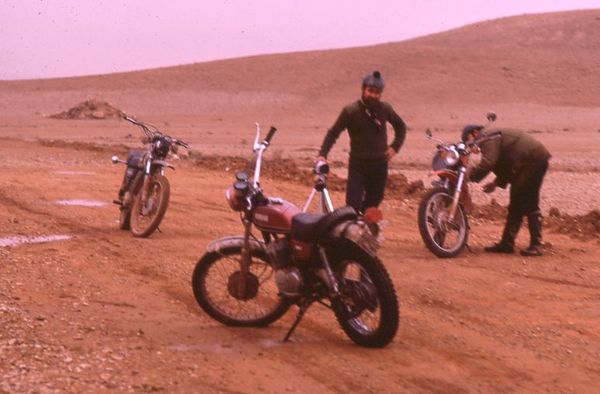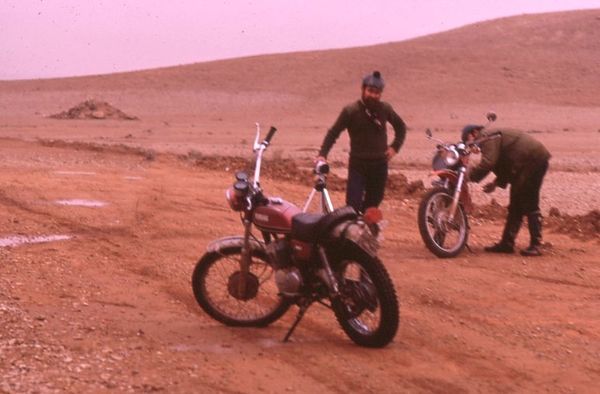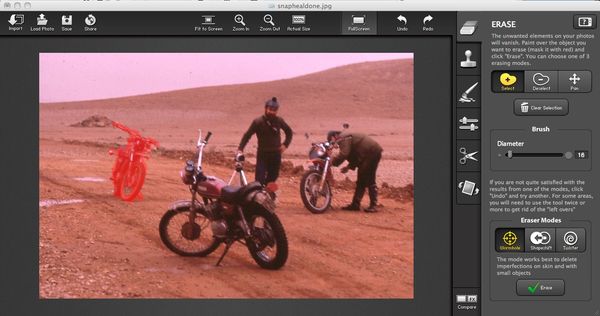Posts for: kintekobo
Dec 25, 2011 04:54:54 #
I thought that this imported/grey import versus official channel warranty issue had been addressed. I am pretty sure that it has here in the UK. unless I am mistaken I am pretty sure that the manufacter must honour the warranty no matter where you buy the product. I know they will try to weasel out of it but if you stop to think about it, it is unfair practice to deny responsibility for your product in one country just because it was purchased in another. I bought a Nikon Fish-Eye lens from a camera shop in Chicago and when back here in the UK I thought I might need a repair Nikon assured me that the warranty was good. I'm not a legal expert but hopefully someone else might be able to chip in with the full skinny on this.
oh, and by the way, Merry Christmas everyone.
oh, and by the way, Merry Christmas everyone.
Dec 24, 2011 11:30:42 #
marvin Klein wrote:
kintekobo
Not bad you should have gotten rid of the shadows.
Sorry i too an anal for i have been in the advertising business and retouching in photoshop. So i pick up on these things. if your not looking and comparing then its a good job.
Not bad you should have gotten rid of the shadows.
Sorry i too an anal for i have been in the advertising business and retouching in photoshop. So i pick up on these things. if your not looking and comparing then its a good job.
Marvin,
I really just wanted to show what SnapHeal could do without any other adjustment. It really did take no more than three minutes start-to-finish to do the motorbike removal. I use it to do the initial clean up and then take the output of Snapheal into PhotoShop to tidy it up.
Dec 24, 2011 09:36:47 #
If you have a Mac there is a program called SnapHeal which does a pretty good job of removing unwanted artefacts from a picture. It was on offer for $9.99 a few days ago at www.macupdatepromo.com so not very expensive.
It comes from a company called MacPhun and can be found here -
http://www.macphun.com/
I have no affiliation with the company, just a user. I thought that for ten bucks it was worth a try and if it was no good then i had hardly wasted a fortune. Turns out that it's actually pretty good.
I have an example of the sort of thing that it can do. I am just scanning in some very old slides from when I was in Saudi Arabia and I took one through SnapHeal. It took the grand total of 3 minutes to remove the motorbike. Not bad for a cheap program. You just draw over the item you want to remove and tell it to get to it as you can see from the third picture.
It comes from a company called MacPhun and can be found here -
http://www.macphun.com/
I have no affiliation with the company, just a user. I thought that for ten bucks it was worth a try and if it was no good then i had hardly wasted a fortune. Turns out that it's actually pretty good.
I have an example of the sort of thing that it can do. I am just scanning in some very old slides from when I was in Saudi Arabia and I took one through SnapHeal. It took the grand total of 3 minutes to remove the motorbike. Not bad for a cheap program. You just draw over the item you want to remove and tell it to get to it as you can see from the third picture.
Original Scan

SnapHealed

Snapheal in action

Dec 23, 2011 06:37:38 #
Also remember to only use silica gel packs to absorb moisture if you are going to pack equipment for any length of time. Do NOT use the cheap home de-humidifier packs, the sort you can buy in DIY shops, as these usually contain calcium chloride as the dessicant. These can release vapours that will attack electronic equipment as i know to my cost, having left a radio next to one of these in a cupboard. After several months it completely destroyed the circuit board on the radio.
Dec 23, 2011 06:23:51 #
I have an EyeFi Pro which I use with my Nikon D7000 and although it does work there are one or two gotcha's that need to be understood.
1. Since the wireless is built inside an SD card it has a very small antenna. This means that the range is quite limited and especially so with the Nikon D7000 since it has a metal body with considerable amount of rubber on the cover of the card slot. This reduces the signal, and therefore the range, by quite a lot as I found when I opened the door on the card slot and found that I could double the range.
2. Holding the camera normally places your hand over the SD card bay. This results in additional attenuation of the signal since the hand has a very strong attenuation factor at 2.4GHz which is the frequency used by these cards.
3. You can set up a 'direct-mode' connection between the EyeFi card and a PC or an iPad but trust me this can be a frustrating experience. It took me several days of buggering about, trying this and that, before I managed to get it to upload to my iPad reliably. Most of the time it would just refuse to make a connection, or would connect and then just drop the connection.
4. I'm not sure that the hardware is completely without problems as I had to return my card twice before I got one that worked properly, and even then it suffers from the problem of short range caused by the D7000 having a lot of metal around the SD card slot.
All-in-all I think that the EyeFi card could be a very useful tool, and certainly if you use it in a typical home network where you have the usual wi-fi access point it is a lot easier than using tethering, or removing the SD card for transferring pictures to a pc. And in fairness I should point out that getting it to work in the non-direct mode (the default) is very straightforward. I just think that they need to make the software more robust and the direct mode more easy to get working.
1. Since the wireless is built inside an SD card it has a very small antenna. This means that the range is quite limited and especially so with the Nikon D7000 since it has a metal body with considerable amount of rubber on the cover of the card slot. This reduces the signal, and therefore the range, by quite a lot as I found when I opened the door on the card slot and found that I could double the range.
2. Holding the camera normally places your hand over the SD card bay. This results in additional attenuation of the signal since the hand has a very strong attenuation factor at 2.4GHz which is the frequency used by these cards.
3. You can set up a 'direct-mode' connection between the EyeFi card and a PC or an iPad but trust me this can be a frustrating experience. It took me several days of buggering about, trying this and that, before I managed to get it to upload to my iPad reliably. Most of the time it would just refuse to make a connection, or would connect and then just drop the connection.
4. I'm not sure that the hardware is completely without problems as I had to return my card twice before I got one that worked properly, and even then it suffers from the problem of short range caused by the D7000 having a lot of metal around the SD card slot.
All-in-all I think that the EyeFi card could be a very useful tool, and certainly if you use it in a typical home network where you have the usual wi-fi access point it is a lot easier than using tethering, or removing the SD card for transferring pictures to a pc. And in fairness I should point out that getting it to work in the non-direct mode (the default) is very straightforward. I just think that they need to make the software more robust and the direct mode more easy to get working.
Dec 21, 2011 10:15:15 #
SnowBear:
A perennial problem when sending photographs to someone else is monitor/printer calibration. You may have come up with a cheap alternative to those expensive monitor calibration tools. Send the images along with a picture of some M&M's and tell the recipient to go buy a packet and tune the monitor to match. Woo-Hoo! I like it! :thumbup:
A perennial problem when sending photographs to someone else is monitor/printer calibration. You may have come up with a cheap alternative to those expensive monitor calibration tools. Send the images along with a picture of some M&M's and tell the recipient to go buy a packet and tune the monitor to match. Woo-Hoo! I like it! :thumbup:
Dec 21, 2011 08:00:46 #
SnowBear.
What a neat choice of subject! I never thought of using M&M's as a colour standard for reference but I would imagine that since manufacturers have very strict guidelines with regard to contents it would be a fair bet that my M&M's would be very close to to your's in colour match.
What a neat choice of subject! I never thought of using M&M's as a colour standard for reference but I would imagine that since manufacturers have very strict guidelines with regard to contents it would be a fair bet that my M&M's would be very close to to your's in colour match.
Dec 15, 2011 10:02:55 #
Plieber wrote
No, I'm afraid it hit the junk pile a long time ago. Curiosity got the better of me one day (that's how I found out what was inside!) and I never managed to get it back together again so that it worked correctly. Shame really because it was beautifully made.
Quote:
Wow, I saw and heard about a lot of strange equipment working at the family's photo store, but I never encountered anything like you describe. If you still have it, it would be worth something.
No, I'm afraid it hit the junk pile a long time ago. Curiosity got the better of me one day (that's how I found out what was inside!) and I never managed to get it back together again so that it worked correctly. Shame really because it was beautifully made.
Dec 15, 2011 06:49:54 #
I had a 'light meter', made by Voigtlander if I recall correctly, which was bizarre in the extreme. It was like a small square telescope, about 3" long. You looked through an eyepiece and saw the scene with the left half of the image coming through a neutral density filter and the right half through another filter which faded gradually from clear to completely opaque. You turned a knob which rotated the graduated filter until both halves of the image were the same brightness then read off a scale what the aperture setting would be for a particular shutter speed and ASA.
Daft as it sounds it actually worked pretty well provided there was plenty of light. I used it for quite some time even after I bought my first 35mm film camera with TTL ( a trusty old Zenith).
Daft as it sounds it actually worked pretty well provided there was plenty of light. I used it for quite some time even after I bought my first 35mm film camera with TTL ( a trusty old Zenith).
Dec 15, 2011 06:36:24 #
Quote:
Get a couple of muslim backgrounds, with one of them black and you're in business. Good luck. P.S. I use Adorama for most of my studio stuff.
Phil - I don't think Allah will like you using his followers as a background you know! :D
Nov 24, 2011 09:36:56 #
I have had a Canon i9950 printer for a few years now and have had nothing but excellent results.
Plus points are that it does A3 and that it has seven individual ink cartridges so good colour reproduction and no wasted ink.
Negative points are that it is rather large and heavy and was quite expensive, although I think you can pick them up used for very reasonable prices.
Plus points are that it does A3 and that it has seven individual ink cartridges so good colour reproduction and no wasted ink.
Negative points are that it is rather large and heavy and was quite expensive, although I think you can pick them up used for very reasonable prices.
Nov 24, 2011 09:08:28 #
Another point that is often missed is to do with the different way that digital and film record the colour range. With emulsion on film the colour range is continuous but with digital it is 'quantized' into discrete steps determined by the number of bits. For example a 24 bit colour image comprises of 8 bits of red information, 8 bits of blue and 8 bits of green. The combination of these three give a colour palette of 16 million.
However, that means that the range of any single red, green or blue colour can only be expressed in 256 distinct steps ( 8 bits ) whereas the chemical used in film emulsion registers the colour range as a continuous 'flow' with no steps between one level and the next.
The end result of this is that film has a more subtle expression of tonal range than digital. This is often noticeable in things like skin tones, or large areas of gradually changing tones such as sky. That is why I still hang on to my old (ancient would be more appropriate) F2S and shoot film occasionally. Although it must be said it is more out of nostalgia these days as the quality of the digital systems is getting ever better.
However, that means that the range of any single red, green or blue colour can only be expressed in 256 distinct steps ( 8 bits ) whereas the chemical used in film emulsion registers the colour range as a continuous 'flow' with no steps between one level and the next.
The end result of this is that film has a more subtle expression of tonal range than digital. This is often noticeable in things like skin tones, or large areas of gradually changing tones such as sky. That is why I still hang on to my old (ancient would be more appropriate) F2S and shoot film occasionally. Although it must be said it is more out of nostalgia these days as the quality of the digital systems is getting ever better.
Nov 15, 2011 15:33:00 #
A face that only a mother could love!
Nov 15, 2011 14:23:41 #
I was going to give details of the object but I thought it might be amusing to see if anyone can guess what it is. It is in fact a Titanium Posidrive bit, diameter is 1.7mm.
Nov 15, 2011 12:57:54 #
I mostly use macro for shooting mechanical objects in order to observe damage or unusual wear. Just occasionally I get one that has an interesting look to it, rather like this one which I thought had a touch of the alien artefact about it.
This was shot with a Nikon D7000, Nikkor 50mm F1.8 Prime, PB-5 bellows, Neewer ring light, Tiffen polarising filter. Exposure was 3 seconds at F22.
This was shot with a Nikon D7000, Nikkor 50mm F1.8 Prime, PB-5 bellows, Neewer ring light, Tiffen polarising filter. Exposure was 3 seconds at F22.
